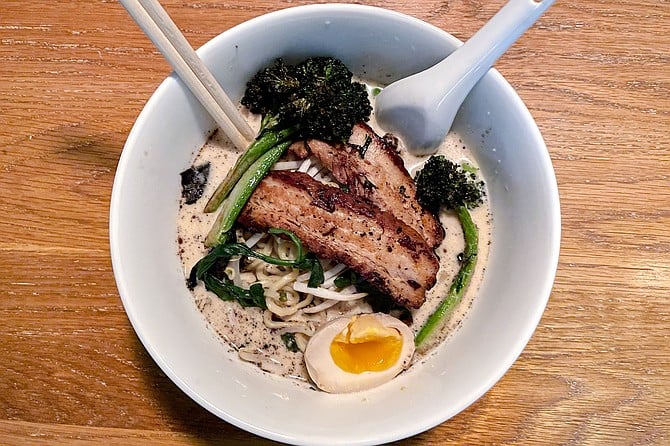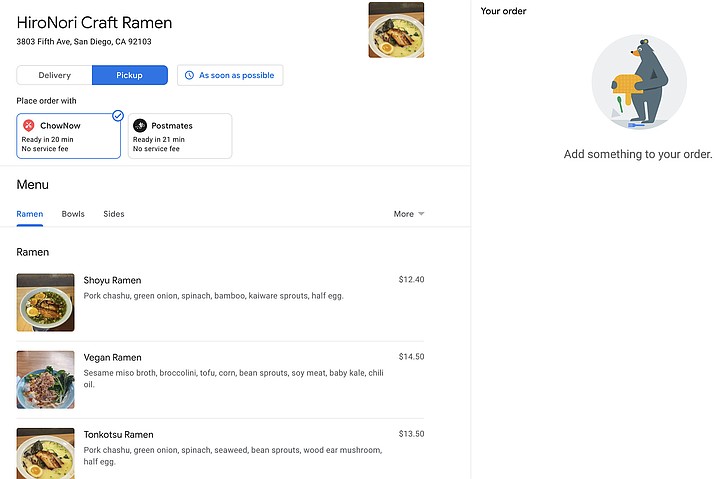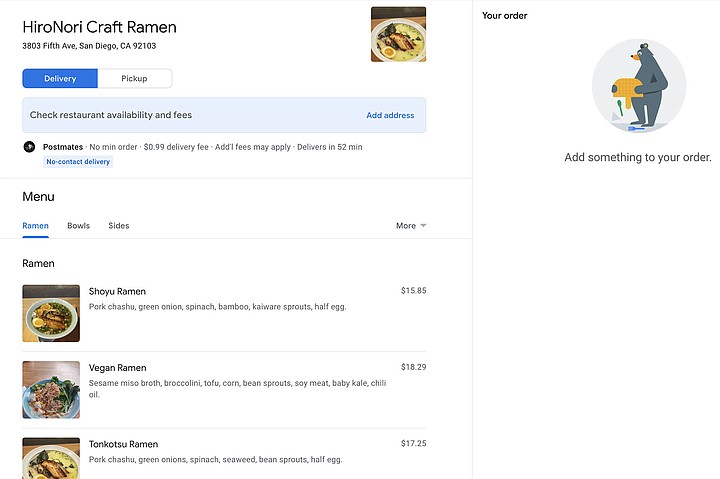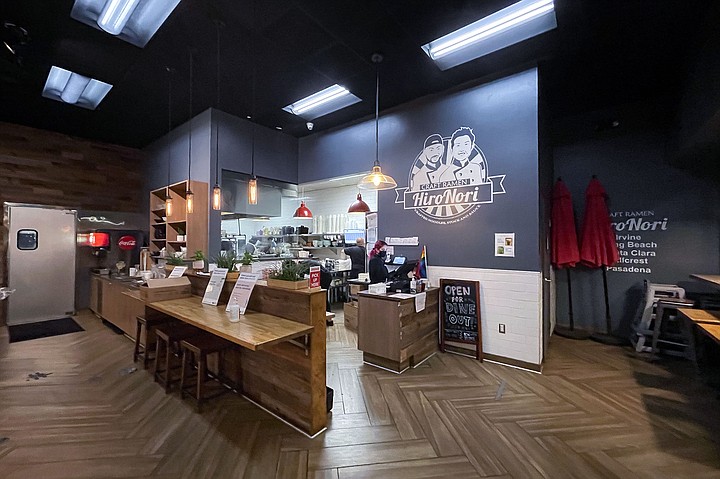 Facebook
Facebook
 X
X
 Instagram
Instagram
 TikTok
TikTok
 Youtube
Youtube

Restaurant delivery apps were already thriving before the pandemic hit, and without doubt they have benefited from our current all take-out, all-the-time dining culture. But, if you’ve used any over the years, you may have noticed the surcharges have been creeping ever upward. However, thanks to recently added Google functionality, it’s become easier to figure out how much extra delivery costs these days.
I found a startling example this week, when I went online to order food from one of my favorite ramen spots: HiroNori Craft Ramen in Hillcrest. My web search led me to the HiroNori page on Orderfood.google.com.
At first, I mistook Orderfood for a new, Google-powered delivery service, meant to compete with Uber Eats, GrubHub, etc. But as I examined the page, I realized it simply integrates whatever online ordering options these apps make available. Click on the Delivery button, and it shows you HiroNori’s online menu via the Postmates delivery app. Click the Pickup button, and it shows you the same menu for the ChowNow takeout app.

However, while the menus are the same, the prices are quite different. The shoyu ramen, if you’re willing to drive over and pick it up yourself, costs $12.40. If you order for delivery, it’s $15.85, a $3.45 increase. Along the same lines, the Tonkotsu ramen goes from $13.50 to $17.25 — up $3.75.
In other words, each item gets a roughly 28 percent upcharge for ordering delivery. And that’s before the app adds on service charges to the customer, on top of delivery fees. On top of tax and tip.

I don’t point this out to pick on HiroNori — the difference in price is clearly meant to offset the commission Postmates (like most of its competitors) charges the restaurant for delivery orders. But when all of the above are tallied up, with a modest 10 percent tip, two orders of tonkotsu ramen delivered to my doorstep would cost $47.74.
However, ordering through ChowNow for pickup, the same order costs $32.73. That $15 bucks cheaper. Or to look at it another way, more than 45 percent less.

It’s not like ChowNow doesn’t charge restaurants too. But it charges a flat monthly fee — no commission — in return for providing software for online ordering and credit card processing. Perhaps most disturbing about comparing the two services, is that Postmates takes orders for pickup. It doesn’t charge delivery fees, of course, but it does charge commission, meaning if you order HiroNori takeout through Postmates rather than ChowNow, you’ll see those 28 percent higher prices.
As for delivery and pickup, when I compared the prices of different sized orders, delivery always seemed to wind up costing about 45 percent more through Postmates.
Meanwhile, other delivery apps, such as Uber Eats (which recently bought Postmates) have taken to adding a new one- or two-dollar charge in the new year. Nebulously described as “driver benefits,” its stated purpose is to cover earnings and benefit requirements laid out by Prop 22. That would be the California ballot initiative, sponsored by the likes of DoorDash and Uber, that passed in November, allowing said businesses to continue paying their drivers as independent contractors rather than full-time employees. As with most corporate-sponsored propositions, the final costs end up being paid for by the average consumer.
Without question, ordering contact-free restaurant delivery is easier than ever, especially during a pandemic. But going to visit the emptied out HiroNori to pick up my food wasn’t all that challenging. And with the money I saved, I paid for black garlic oil and broccolini add-ons to my ramen. Which was perfect, as always.


Restaurant delivery apps were already thriving before the pandemic hit, and without doubt they have benefited from our current all take-out, all-the-time dining culture. But, if you’ve used any over the years, you may have noticed the surcharges have been creeping ever upward. However, thanks to recently added Google functionality, it’s become easier to figure out how much extra delivery costs these days.
I found a startling example this week, when I went online to order food from one of my favorite ramen spots: HiroNori Craft Ramen in Hillcrest. My web search led me to the HiroNori page on Orderfood.google.com.
At first, I mistook Orderfood for a new, Google-powered delivery service, meant to compete with Uber Eats, GrubHub, etc. But as I examined the page, I realized it simply integrates whatever online ordering options these apps make available. Click on the Delivery button, and it shows you HiroNori’s online menu via the Postmates delivery app. Click the Pickup button, and it shows you the same menu for the ChowNow takeout app.

However, while the menus are the same, the prices are quite different. The shoyu ramen, if you’re willing to drive over and pick it up yourself, costs $12.40. If you order for delivery, it’s $15.85, a $3.45 increase. Along the same lines, the Tonkotsu ramen goes from $13.50 to $17.25 — up $3.75.
In other words, each item gets a roughly 28 percent upcharge for ordering delivery. And that’s before the app adds on service charges to the customer, on top of delivery fees. On top of tax and tip.

I don’t point this out to pick on HiroNori — the difference in price is clearly meant to offset the commission Postmates (like most of its competitors) charges the restaurant for delivery orders. But when all of the above are tallied up, with a modest 10 percent tip, two orders of tonkotsu ramen delivered to my doorstep would cost $47.74.
However, ordering through ChowNow for pickup, the same order costs $32.73. That $15 bucks cheaper. Or to look at it another way, more than 45 percent less.

It’s not like ChowNow doesn’t charge restaurants too. But it charges a flat monthly fee — no commission — in return for providing software for online ordering and credit card processing. Perhaps most disturbing about comparing the two services, is that Postmates takes orders for pickup. It doesn’t charge delivery fees, of course, but it does charge commission, meaning if you order HiroNori takeout through Postmates rather than ChowNow, you’ll see those 28 percent higher prices.
As for delivery and pickup, when I compared the prices of different sized orders, delivery always seemed to wind up costing about 45 percent more through Postmates.
Meanwhile, other delivery apps, such as Uber Eats (which recently bought Postmates) have taken to adding a new one- or two-dollar charge in the new year. Nebulously described as “driver benefits,” its stated purpose is to cover earnings and benefit requirements laid out by Prop 22. That would be the California ballot initiative, sponsored by the likes of DoorDash and Uber, that passed in November, allowing said businesses to continue paying their drivers as independent contractors rather than full-time employees. As with most corporate-sponsored propositions, the final costs end up being paid for by the average consumer.
Without question, ordering contact-free restaurant delivery is easier than ever, especially during a pandemic. But going to visit the emptied out HiroNori to pick up my food wasn’t all that challenging. And with the money I saved, I paid for black garlic oil and broccolini add-ons to my ramen. Which was perfect, as always.
Comments